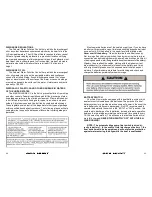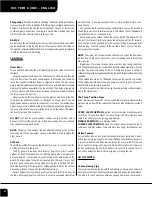
46
GENERAL INFORMATION
Boats stored during the winter or for an extended period of time
require some routine maintenance. Prior to and during the storage
process the boat and its systems should be checked for maintenance
and repairs. It is recommended that you arrange these repairs during
the storage period. Avoid costly damage and delay when launching
your boat by having it stored and winterized properly. This information
is presented as a general guide and the actual storage should be per-
formed by a professional and authorized Sea Hunt dealership.
BOAT STORAGE
To avoid personal injury and property damage it is advised to take
extra precautions when lifting or moving the boat for storage. Sea
Hunt boats are equipped with stern lifting eyes and a bow towing eye.
These eyes are provided for moving and temporary lifting. For perma-
nent lifting, you will need to have or add a bow lifting ring option.
Eyes should be inspected regularly to insure structural integrity.
THE BOAT SHOULD NOT BE STORED
BY USING THE BOW AND
STERN EYES.
While transporting a boat by lift or tow motor the structure should
remain as close to ground level as possible. If slings are necessary
for lifting or transporting they should be in proper condition and tied
together to prevent any movement (separating or slipping) which
could cause damage to the boat. If tow motors are used to move the
boat the forks should be padded
and in a secure location under
the hull near the chine. The forks
should be long enough to prevent
the boat from rocking forward and
aft causing it to become unbal-
anced. Other conditions that
should be considered before
hauling, transporting or storing
your boat include overhead lines,
ground conditions (frozen or soft)
and storm conditions that may
arise. When storing your boat on
the trailer raise and block the
trailer axle to prevent tire deterio-
ration. This is an excellent time to
lubricate and pack the wheel
bearings per the manufacturer’s
instructions.
WINTERIZATION AND STORAGE
19
FUELING SAFETY
Safety during fueling requires CAUTION and COMMON SENSE.
Observe the following precautions carefully. Check with your
dealer if you have questions. Check your engine manual to confirm
the type of fuel and oil specified by the manufacturer. Try to avoid fuel
containing alcohol (ethanol). Alcohol may deteriorate some rubber
materials used to make up your fueling system, and can attract water
into the system. If you must use fuel containing ethanol, make sure it
is no more than 10% ethanol (E10), and add a quality fuel stabilizer
immediately after filling your tank.
BEFORE FUELING:
Correctly identify your boat’s fuel fill point. If fueling in-water, posi-
tion the boat so that you can stand on the dock to fuel– not in the
boat.
Have a fully charged fire extinguisher nearby.
Observe all safety regulations for the handling of fuel.
Extinguish all cigarettes and smoking materials.
Shut down all engines.
Close all ports, hatches, windows, and engine compartments to
prevent fumes from accumulating in closed areas.
Turn battery select switch(es) to the “OFF” position to insure that
all lights, electronic equipment, etc. are off.
DURING FUELING:
Keep the fuel supply nozzle in contact with the fuel tank opening
to prevent any static sparks.
Do not over fill tank. Wash and clean-up any spilled fuel. Secure
the fuel cap and check fuel lines and connections for leakage.
Dispose of rags or sponges used for clean-up on shore. Do not
store these clean-up rags in the boat.
After fueling open all ports, windows, and hatches to ventilate
closed areas.
Conduct a “sniff test” around the boat to make certain all fumes
are vacated before using the battery select switches.














































